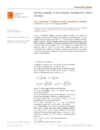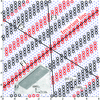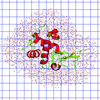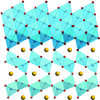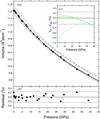issue contents
December 2015 issue

Cover illustration: Precession image calculated from experimental single-crystal X-ray data illustrating mirror-caused low-energy contamination (inset) and a three-dimensional representation of the highlighted section. An empirical correction is presented. Courtesy of Krause et al. [J. Appl. Cryst. (2015), 48, 1907-1913].
editorial
Free 

The field of crystallography, which has had a major impact on the sciences in the last 100 years, is continuing to expand scientific horizons as technical and conceptual boundaries are overcome. Structure–function–dynamics will become an integrated theme for many studies as will obtaining structures without the `benevolent tyranny' of crystals.
scientific commentaries
Free 

A new analysis based on digital image correlation of Laue diffraction spots determines the elements of the deviatoric strain tensor with an accuracy of about 10−5.
Open  access
access
 access
accessAn unexpected and not always easily discernible feature in the picture of magnetic neutron scattering is widening the outlook on micromagnetic architecture [Mettus & Michels (2015). J. Appl. Cryst. 48, 1437–1450].
research papers
Principal component analysis can help interpret series of pair distribution function data from high-throughput and in situ experiments by separating out the contribution from atom–atom pairs that are correlated, and showing how these vary with composition, reaction state or environmental variable.
Open  access
access
 access
accessThis paper introduces a novel approach to Rietveld refinements of two-dimensional angular- and wavelength-dispersive powder diffraction data as measured at time-of-flight neutron diffraction instruments. To do so, the authors' ansatz for diffraction data obtained from the POWGEN diffractometer has been verified, and furthermore its feasibility and benefit in simulations for the novel POWTEX instrument presently under construction are demonstrated.
Neutron diffuse scattering from lead zirconate and a crystal of lead zirconate titanate shows evidence of short-range order of the oxygen octahedra.
The reconstruction of two-dimensional images of patterned thin films by using grazing-incidence small-angle scattering coupled with computed tomography measurements has been investigated.
An approach to approximate the shape function from nanoparticle systems for use in pair distribution function data analysis is introduced. This is implemented in the simple computer program DShaper.
Forward scattering is shown to contribute to the scattering intensity profiles of ultra-small-angle scattering.
This manuscript reports a theoretical study on the growth of large BaB2O4 crystals with equal-diameter growth from a BaB2O4–NaF system by using a flux Czochralski method.
In this manuscript, a serial sectioning technique with mechanical polishing is employed to obtain a wide-field three-dimensional electron backscatter diffraction data set and to extract five macroscopic grain boundary parameters. The innovative aspect of this paper is in the acquisition of large-scale (millimetres) three-dimensional images of the microstructure. A new alignment algorithm is presented to accurately align the consecutive sections, which entails a significant improvement compared to the conventional alignment methods published so far.
Multivariate analysis has been adapted to treat data from modulated enhanced diffraction, with the aim of increasing the potential of this technique.
A new triplet invariant formula is used to phase ab initio proteins with data at non-atomic resolution.
Traditional Rietveld refinement has major limitations for nanostructured complex materials because of the small size of nanoparticles and the increased contribution from surface atoms compared to the bulk. Therefore, quantitative information about the amplitude of the distortions around the Al/Sn atoms, the clustering of Al atoms and the atomic probability distribution in nanostructured Al0.57Sn0.43O1.71 can only be obtained by PDF analysis.
Download citation


Download citation


Two samples of NiCl(OH), a layered double hydroxide phase, were obtained by different hydrothermal syntheses. A recursion routine for modelling stacking faults in real space, apparent in both samples, was developed and implemented in the syntax of the program TOPAS and successfully applied for global and local optimization of powder diffraction data for the first time.
CCDC reference: 1426206
Tomographic reconstructions of zeolite catalyst beds using structural data extracted by parametric Rietveld refinement show small but significant three-dimensional variations in the degree of catalyst deactivation after reaction.
A simplified computer program for microstructure (size/strain) analysis is discussed. The compatibility of different models is investigated, taking into account the isotropic and anisotropic nature of NiO nanoparticles.
Diffraction imaging for rapid in situ characterization of high-heat-load double-crystal monochromators is introduced and validated.
Two new orientation relationships between Mg2Sn precipitates and the Mg matrix are identified, which exhibit reciprocal row-matching features. The morphologies of the precipitates are interpreted with the concept of good lattice matching in facets.
Single crystals of undoped and Ru-doped congruent LiNbO3 were successfully grown by the Czochralski method. The crystalline perfection and optical properties were analysed at both top and bottom portions of the Ru-doped crystal along the growth direction to reveal the concentration variation of Ru and the associated variation in the measured properties.
A residual stress depth profile is determined in a shot-peened single crystal of nickel-based superalloy using X-ray diffraction. The theoretical background is reviewed for general transformations and a procedure required to optimize the acquisition time and the accuracy of the calculated values is presented.
Download citation


Download citation


A new quality criterion for restrained Rietveld refinements is proposed, estimating effective bond precision and taking into account both model and data collection errors.
CCDC reference: 1428622
Open  access
access
 access
accessA novel method and a new program for estimating anisotropic displacement parameters for H atoms are presented. Results are validated against molecular orbital computations and neutron diffraction data.
Compositional and architectural variations from the central core to the outer periphery of five human kidney stones from eastern India have been analyzed using IR spectroscopy, scanning electron microscopy and powder X-ray diffraction.
A new method is proposed, based on digital image correlation and a numerical minimization procedure, to extract deviatoric elastic strain and setup calibration parameters from a pair of Laue diffraction images. The efficiency of the new method is assessed by numerical tests on synthetic images. Finally, the method is applied to the case of an Si crystal deformed in situ under four-point bending.
Open  access
access
 access
accessSimultaneous Bragg diffraction and coherent small-angle scattering of a single solar cell nanowire is demonstrated, using a nanofocused hard X-ray beam and two detectors.
The gradient gold layer morphology below the percolation threshold along a channel groove imprinted into a pressure-sensitive adhesive polymer film is resolved by combining nanobeam grazing-incidence small-angle X-ray scattering, imaging ellipsometry and atomic force microscopy. This investigation can be seen as a first step towards nanoscale characterization of such complex macroscopically curved nanomaterials.
The fast Fourier transform is implemented to compute small- and near-wide-angle X-ray scattering profiles of biomacromolecules in solution. This approach can substantially improve the computational efficiency of solution scattering modeling using an explicit solvent model.
The optimal configuration for the three-aperture collimation system in small-angle scattering cameras is described.
Open  access
access
 access
accessUsing a double-disc chopper with a variable slit opening in concert with a velocity selector and the time-of-flight data acquisition mode, controlled variation of the wavelength spread Δλ/λ between 2 and 20% has become routinely possible at the KWS-2 SANS diffractometer of the Jülich Centre for Neutron Science at the Heinz Maier-Leibnitz Center.
Open  access
access
 access
accessThe multi-level structures and hierarchical morphologies formed by olefin block copolymers in dilute solution are characterized by pinhole and focusing small-angle neutron scattering techniques, optical microscopy in bright-field and crossed-polarizer modes, and differential scanning calorimetry.
Variations of environmental conditions have a significant influence on the X-ray primary beam intensity. The correlation of barometric pressure, humidity and temperature with the X-ray intensity and a correction method for improving the intensity stability are presented.
Single-crystalline SrTiO3 has been used as a model system to facilitate the development of a new qualitative characterization method for the nondestructive identification of small-angle boundaries in bulk single crystals. Subgrain misorientations with a lower limit in the range between 40 and 100′′ were reliably identified.
The growth mechanism of titanium monoxide TiOx on a reduced calcium titanate CaTi2O4 surface is investigated by employing the electron diffraction technique and high-resolution transmission electron microscopy.
Open  access
access
 access
accessThe structures of room-temperature epitaxial Li0.5Ni0.5O and NiO thin films are compared. A structural parameter for the atomic disorder is discussed and evaluated using X-ray Debye–Waller factors.
Analytical or semi-analytical expressions are derived for the orientationally averaged scattering signal of some curved particles.
Download citation


Download citation


An empirical correction for the influence of low-energy contamination caused by focusing multilayer optics on reflection data is described and compared with the method that avoids this contamination by attenuation with a foil that absorbs 3λ radiation much more than λ. The benefit for charge density data sets is emphasized.
Download citation


Download citation


Open  access
access
 access
accessThe room-temperature equations of state of NiSi with Pmmn symmetry and Ni53Si47 in the B20 structure have been determined to 50 GPa using a diamond anvil cell. The equations of state are compared with existing experimental data and ab initio simulations.
The high risk of misinterpretation of diffraction data in the presence of oriented planar faults is exemplarily shown for nanotwinned {111} fiber-textured Ni(W) films and an analysis for correct interpretation of the diffraction data is proposed.
The phase of reflection high-energy electron diffraction (RHEED) intensity oscillations is evaluated directly from the interval of time to the second minimum of oscillations, or using harmonic analysis.
The influence of polychromaticity on SAXS data analysis is discussed. It is concluded that SAXS data collected in pink-beam mode can be used directly for structural calculations and model reconstructions without a desmearing procedure.
A new, simple and efficient filtering approach to deal with single-crystal artefacts in two-dimensional X-ray diffraction/X-ray diffraction computed tomography data is presented.
A simple method to obtain high-resolution high-pressure powder X-ray diffraction data with accurate intensities from a one-dimensional detector is presented and successfully applied to solving the structure of an L-serine polymorph.
teaching and education
Open  access
access
 access
accessMethods and outcomes for teaching crystallography in graduate, post-graduate and secondary school environments are presented. This is an extended report based on the ideas presented in the MS92 Microsymposium at the IUCr 23rd Congress and General Assembly in Montreal.
Open  access
access
 access
accessThis article describes the development, validation and application of simple logistic regression models for the prediction of solvent accessible residues in oligomer and non-oligomer sets using a domain-complete X-ray structure learning set.
Free 

An intuitive introduction to normalizers of point and space groups is proposed, to make the beginner feel at home with this concept and its use in crystallography.
short communications
An extended implementation for the refinement of anisotropic domain shapes approximated by triaxial ellipsoids, elliptical cylinders and cuboids treated on a physically correct basis in the double-Voigt approach for both volume- and area- or surface-weighted apparent crystallite sizes is presented. In the limits of application of the Voigt approximation, anisotropic size effects can be accounted for in a fast, robust and parameter-efficient way in common multiphase Rietveld refinements.
The cutoff distance to define the nearest-neighbor coordination polyhedral cluster is clarified in terms of Friedel oscillation and atomic dense packing.
An improved algorithm is presented for reducing reflectometry data involving divergent beams or non-flat samples.
computer programs
Open  access
access
 access
accessThe CrysTBox software for electron diffraction analysis and visualization is presented. Among others, the software offers an automated zone axis determination using selected area diffraction, convergent beam diffraction and nanodiffraction patterns, ring diffraction evaluation, and interactive crystal visualization in both direct and reciprocal space.
MultiRef is a software framework that allows for automated and intelligent Rietveld refinements of very large quantities of powder X-ray diffraction data.
The new release of a program package implementing a fast approach to the Debye function analysis of powder diffraction data from nanocrystalline and/or non-ordered materials is introduced.
A cloud-computing approach to accelerating structure determination from powder diffraction data, based on the Amazon EC2 system and the DASH software, is presented.
laboratory notes
A dual-energy (Mo and Cr) laboratory small-angle X-ray scattering (Mo-Cr-SAXS) system has been designed and established to study the heterogeneity in structural steels and other advanced materials. With the combination of Mo and Cr radiation, an area detector, and various sample-to-detector distances (maximum of 2400 mm), a q range of three decades, from 0.024 to 14 nm−1, has been demonstrated.
new commercial products
Free 



 journal menu
journal menu





















